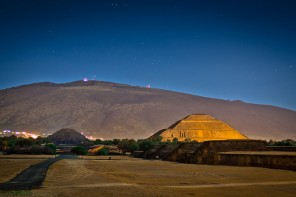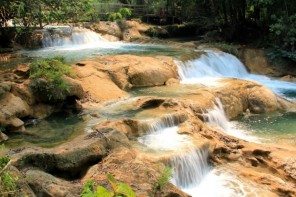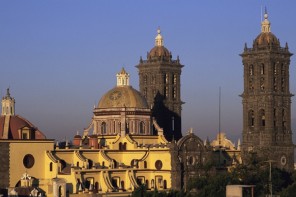Nestled in the mountains of the Central Plateau, Taxco calls itself Mexico’s SIlver City because of the abundance of the metal in times go by, and now because of the exquisite pieces fashioned by its modern craftsmen.
A picturesque place whose singular features are surprising a city nailed in the side of the Atachi hills, surrounded by gigantic mountains, and traversed by a series of ravines. It’s here where you can see one of the most beautiful cathedrals that exists, Santa Prisca. Detached by its majestic beauty that at some point, it has converted into the essential symbol of the unforgettable tourist state of Guerrero: Taxco de Alarcon.
There is an element that has distinguished this city since the 16th century up until now: silver. A precious metal that permitted the surge of an important mining industry that, like the characteristic of its metal, shined in a notable manner in the times of New Spain. In 1528 the town of Tetelcingo was established in a mining camp next to the towns of Cantarranas and Tenango, and in 1570 they came to form the city known as Real de Minas de Taxco. Of these three camps only Tetelcingo was able to transform itself in the 18th century to the town that we know of today, sprouting up not only as a notable mining center, but as a city of unique architectural characteristics. Speaking of its features, there is no doubt that Taxco owes a debt of gratitude to don Jose de la Borda, a Spaniard who was born in the Pyrenees Mountains on the border of Spain and France, who established Taxco as a city in the 18th century. He outlined the panoramic aspect of the city, such as the building structures and its most precious symbol, the Catedral de Santa Prisca (Santa Prisca Cathedral). It is a monument whose greatness contrasts with its simplicity of this small village from white walls to red roofs.
Don Jose de la Borda ordered the construction of the Catedral as a form of gratitude to God for the fortune that he accumulated in the exploitation of the silver. However, during one economic crisis De la Borda sold the temple to the Catedral Metropolitana (Metropolitan Cathedral). This magnificent monument began to construct itself in 1748 and was finished on September 3, 1758.
According to the information from the National Archives, the person credited for creating this magnificent piece of art was Zigüenza. In its interior you can observe proud golden Churrigueresque altarpieces, done with impeccable esthetic sense by don Vicente de Balbas. In the same manner, the temple houses magnificent pictorial works by don Miguel de Cabrera, such as a baroque style organ that was made in Spain.
Another important person in the development of this colonial spot was William Spratling. Who, when arriving in 1931, formed the silversmith center that combined the elegance of their designs and the talent of the silversmiths, that ennobled the creative art and propagated the cities name around the world.
In Taxco there exist many places that are worth visiting, like the Museo Guillermo Spratling (Guillermo Spratling Museum). The museum has two permanent exhibition rooms that contain a collection of 293 pre-Hispanic pieces, and a temporary exhibition room dedicated to showing the talent of the local artists. The Casa Humboldt (Humboldt House) was constructed in the second half of the 19th century in a baroquean style, and after its restoration in 1991, it converted into an interesting museum that today holds many pieces of sacred vicereinal artwork through out its 14 rooms. Through the stay of baron Alexander Von Humboldt in this house, while he made a trip from Acapulco to Mexico City, he gave it the name that we know it by today: Museo de Arte Virreinal de Taxco (Vicereinal Art Museum of Taxco). There are many other interesting places to visit in Taxco: the Museo de la Platería (Silversmith Museum), inaugurated during the celebration of the Feria Nacional de la Plata (National Silver Fair) in 1988, located next to the Patio de las Artesanías (Handicraft Patio); the Casa Borda (Borda House), constructed under a baroque style just in front of the main plaza, the resting place of the miner who erected the Catedral in the city; the Hacienda del Chorrillo, located between the Mulata and the Chorrillo rivers, constructed in 1534 by Hernán Cortés’s soldiers, being in reality the Centro de Estudios para Extranjeros (Center of Studies for Foreigners) for the Universidad Nacional Autónoma de México (National Autonomous University of Mexico).
Close to Taxco is a place that evokes a numerous amount of legends that in itself represents an extraordinary attraction that delights all the senses: the Grutas de Cacahuamilpa (Cacahuamilpa Caves). Its name is of Náhuatl dialect that means “En la sementera del cacahuate” (In the seeding of the peanut), and in this place you can journey through more than 90 naturally made caverns where nature has created arrogant stalactites and stalagmites. But that is not all! The visitor can’t miss out in visiting the archaeological zone of Ixcateopan de Cuauhtémoc, about 38 kilometers from the city of Taxco. Here, the remains of the last Aztec emperor, Cuauhtemoc, are buried. You can also visit the Museo de Resistencia Indigena (Museum of Indigenous Resistance), the church of Santa Maria de la Asuncion, and the archaeological zone that dates back to more than 1500 years before the arrival of the Spanish.
Marvel at Taxco de Alarcon! A city whose name precedes that pre-Hispanic town Tlachco, “Lugar del juego de pelota” (Place of the ballgame), where the temperate and fresh climate of the night conquers the hearts of the visitors. No doubt that if Taxco shines like its silver or marvels in its architectural beauty and colonial semblance, it will make this city an unforgettable tourist destination.





